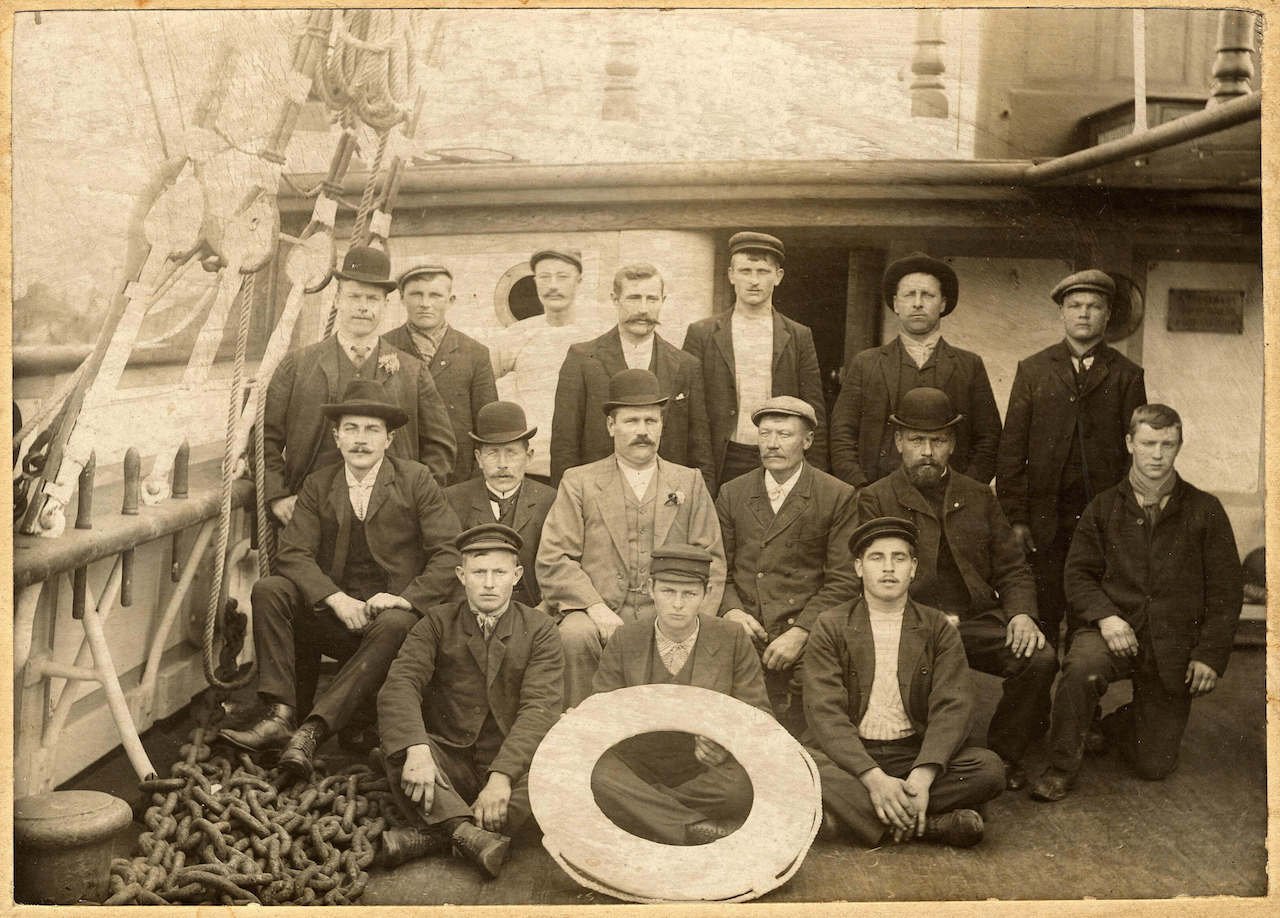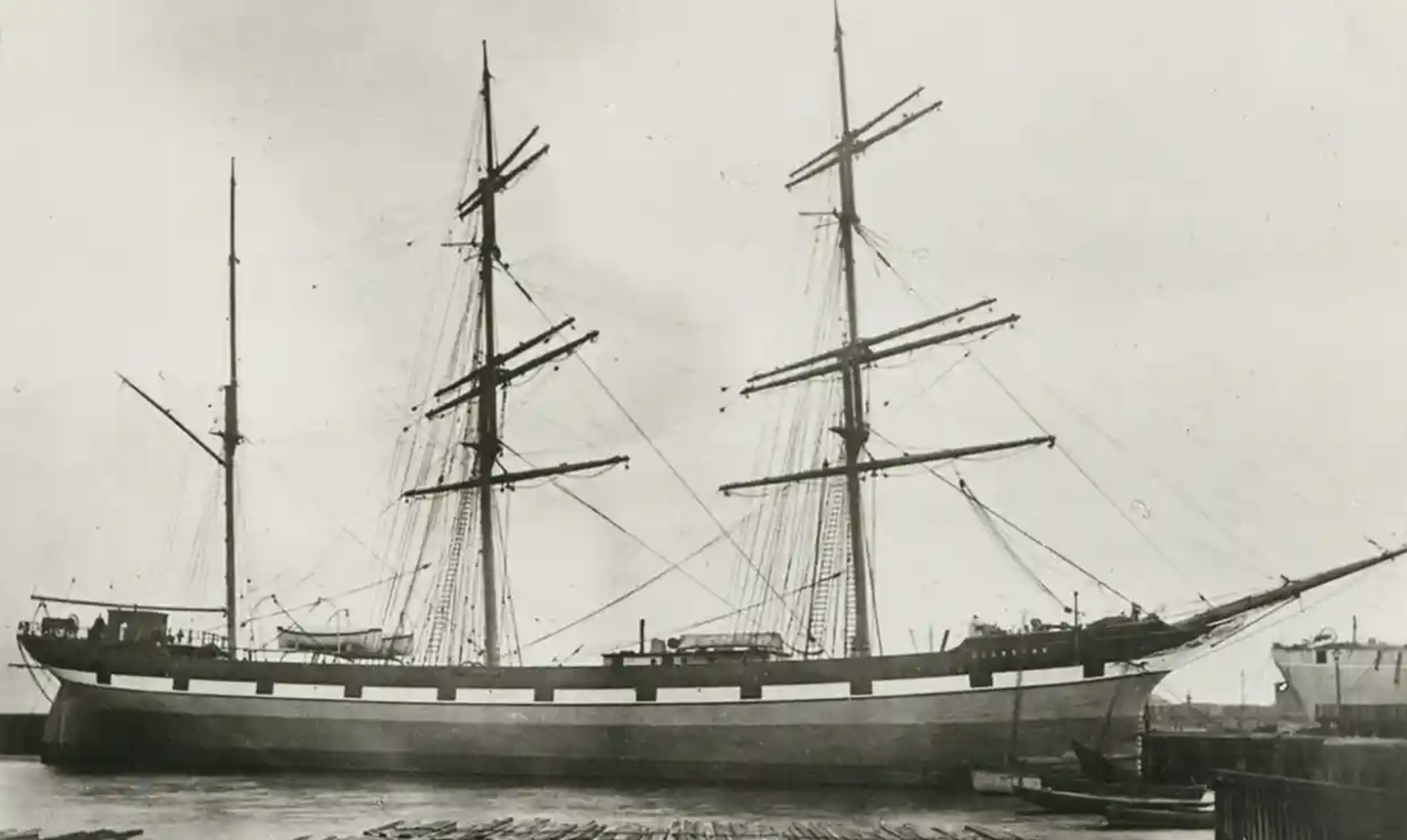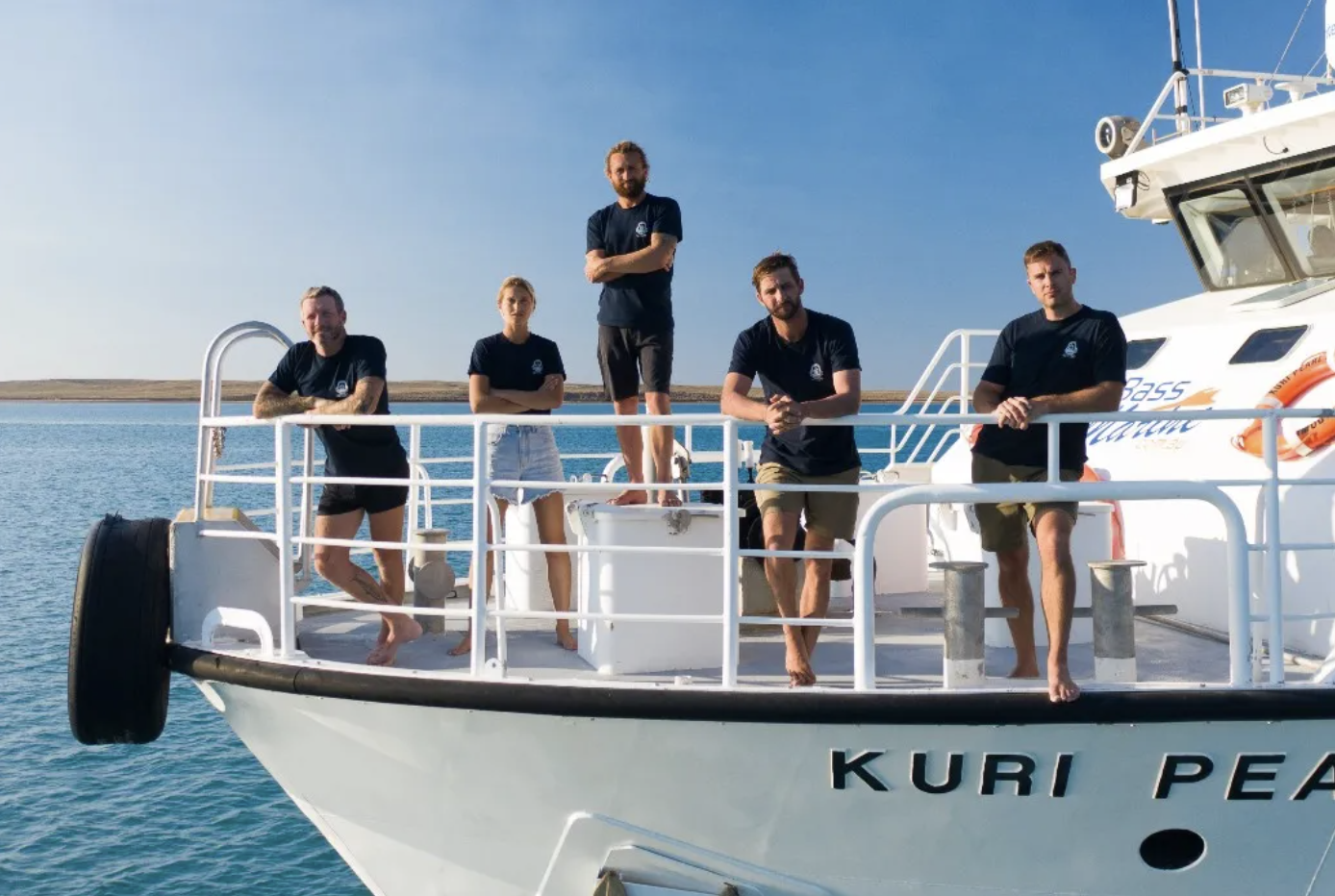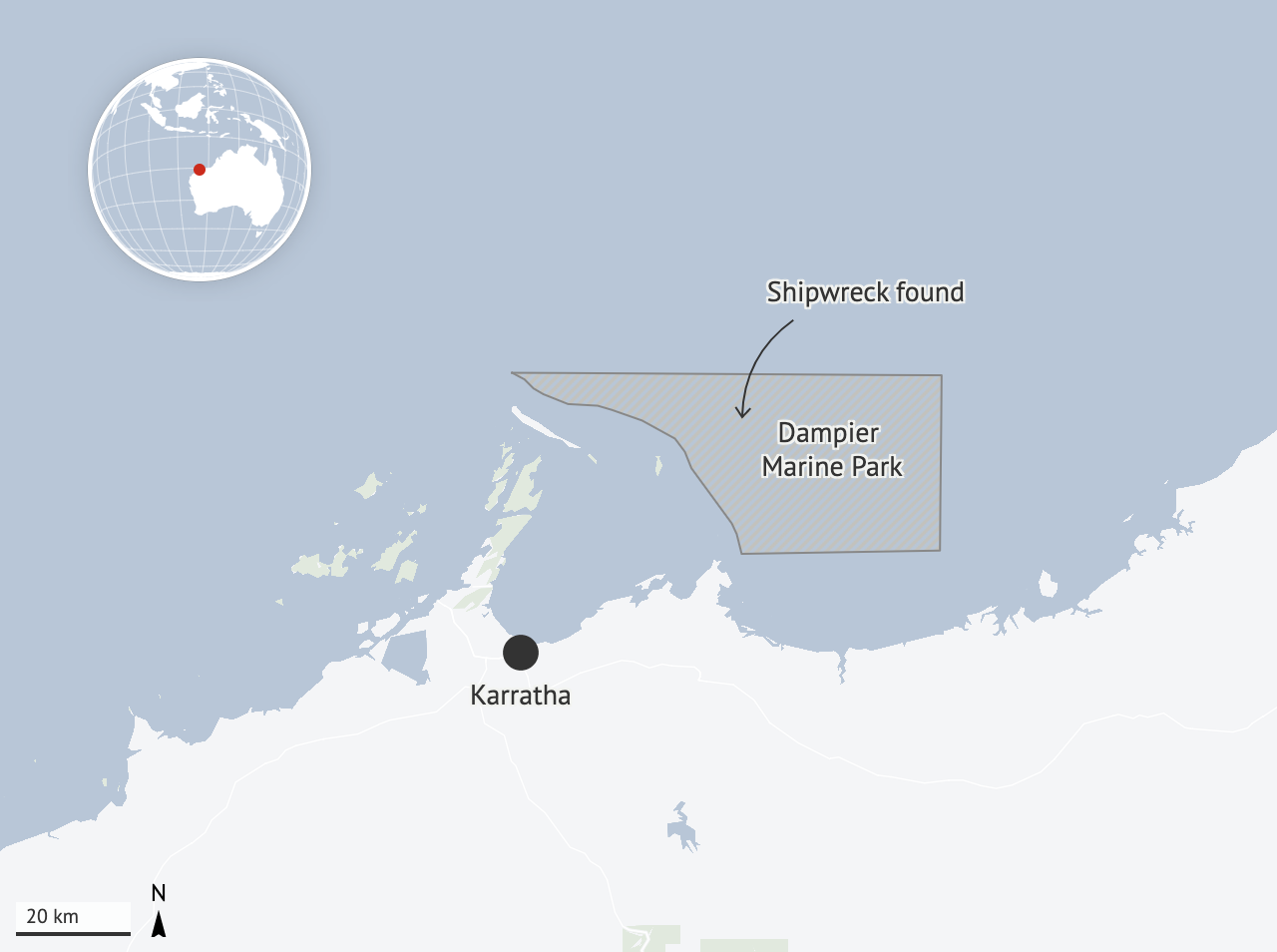The GLENBANK Re-Discovered
The GLENBANK crew before the disaster
The sunken wreck of Finnish-owned sailing ship Glenbank, missing for more than 100 years, has been discovered this week by divers on new Disney+ series “Shipwreck Hunters Australia.”
Discovered in the spectacular Dampier Marine Park, off the coast of Western Australia, the the Scottish-built cargo ship sank with more than 20 crew on board in 1911.
“A lot of our team are deep sea divers and a huge passion of ours is filmmaking, shipwrecks, wildlife, and we all sort of came together some time ago and now we specialise in underwater cinematography,” says diver and historical researcher Johnny Debnam.
“Collectively, we’ve probably spent a couple of years of our lives underwater.”
Debnam and his team sent down a remote camera off shore when they saw marine life congregating on the surface.
“It’s a really special spot. We’re in the middle of the ocean, there’s no land in sight but we’ve seen congregations of humpback whales, bullsharks, hammerhead sharks, every sort of tropical Northwest species you can imagine. They’re all meeting in this area. So that’s what really got us curious to lowering a camera and ultimately making a discovery.”
In November 1910, the steel barque GLENBANK arrived at Balla Balla, Western Australia and had been chartered by Whim Well Copper Mines Ltd to transport copper ore from Balla Balla to the United Kingdom. The ship’s crew was made up of 20 plus members (mostly Russian, Norwegian, and Finnish) and was under the command of Finn, Captain Fredrik Moberg.
Debnam says WA’s massive coastline is dotted with wrecks that all tell tragic stories.
“A lot of the stories behind these wrecks in Western Australia are like a Hollywood script. So we knew we were onto something,” he explains.
“We have a lot of exposed reefs, there are cyclones. Before modern technology of GPS they were sort of navigating from nature basically, using the stars but celestial navigation wasn’t very accurate. So that’s sort of what caused a lot of these old ships to crash into the reefs. There’s around 1500 wrecks in Western Australia and only a quarter of those have been found. So there’s still a lot of discoveries to be made.”
The evidence gathered by the team and extensive research determined that GLENBANK came to its demise due to unsecured cargo of copper ore loaded at Balla Balla where, during a ferocious storm, the precious cargo shifted and caused the ship to capsize, splitting the hull and deck structure apart.
For Debnam, the hunt is not merely about claiming lost treasures or gold but the history and the success stories.
“All historic shipwrecks are protected by the Australian government. But that’s a good thing, so they don’t get all looted. Back in the ’70s, when people were finding Dutch treasure ships, they were going out there with dynamite and blowing up these wrecks to get the treasure. So it’s a good thing that that doesn’t happen anymore. They’re a really special place, these wrecks. They’re a resting ground for sailors who have passed away and they’ve also become marine sanctuaries now as well.”
Yet there was one unfinished story from the GLENBANK – its one and only survivor Antti Ketola, was a 22-year-old Finnish seaman, who managed to get to safety on Legendre Island before being rescued by the pearling lugger, PEARL.
Remarkably, the Shipwreck Hunters Australia team was able to track down Antti Ketola’s descendants in Finland who had no idea about their fore-father’s incredible shipwreck story.
“It was really special to be able to share that story with Antti’s relative. He didn’t even know about that.”
Maritime Archaeologist, Dr Deb Shefi from Western Australian Museum said: “The discovery of GLENBANK is very significant in helping tell the tale of global trade at the turn of the century and giving a voice to those who tragically lost their lives on that fateful day in 1911.
“It is not often we find a silhouette of a ship, with the masts aligned, resting on the seafloor like this. The unseasonably good weather meant GLENBANK was ready to shed its secrets and we were able to record measurements and details that will assist further research into this tragic shipwreck.”
The series uncovers a number of other incredible shipwreck stories throughout each episode, including the discovery of a Dutch Dornier Do-24K flying boat operated by the Netherlands Naval Aviation Service (Marineluchtvaartdienst), one of fifteen flying boats destroyed in an air raid from World War 2. This discovery was one of the most significant finds in Broome in over twenty years, and the culmination of decades of research.
And then there are the inherent dangers.
“The obvious ones are sharks, but we were diving in crocodile infested waters in Broome with zero-visibility while we’re diving. We’re basically diving blind with crocs in the area. The ocean itself is always the biggest danger, because we’re diving at really deep depths, pushing the limits. It’s usually the ocean itself that causes most of the accidents,” Debnam continues.
“But I think our fascination for everything that we find underwater overrides that fear of ‘what could happen?’ We’ve all done a lot of training, we’re very respectful of the dangers. But I think our fascination just overtakes that.
Report from tvtonight.com.au
The GLENBANK in full flight.
From The West Australian-Monday 13th February 1911
THE WRECK OF THE GLENBANK. SURVIVOR'S THRILLING NARRATIVE
From the telegrams received yesterday it seems that there can be little or no hope left of there being any other survivors from the ill-fated barque GLENBANK, which foundered on Monday night last in a hurricane off Legendre Island, some 20 miles from Cossack. The narrative of the sole known survivor, Antle Kitala, shows that the disaster occurred almost in a moment. He and the third mate were in the rigging at the time, and were thrown clear when the vessel capsized, and it seems that these two men and Ericson, the ship's cook, who had parted company with the GLENBANK immediately before she sank, were the only three to remain on the surface when the ship went down. Kitala relates that he presently lost sight of his mates after a tremendous wave had passed by, and that he finally reached shore without seeing either of them again. By means of an interpreter Kitala is able graphically to describe the incidents of the wreck and to furnish a list of the members of the crew. The police cutter, which was sent out to search the islands for signs of the missing men had apparently not returned to port up till late last night.
HOW THE DISASTER OCCURRED.
In the absence of anyone capable of interpreting for Antle Kitala, the sole survivor of the wrecked barque, the postmaster of Roebourne yesterday utilised the telephone service between Roebourne and Whim Creek, a distance of 55 miles. With the help of the Whim Creek postmaster (Mr. Gerrans) he succeeded in getting into communication with a Swede named Narssen, who had travelled on the GLENBANK as a seaman on her last voyage. With Narssen's assist ance the following story of the disaster was elicited from Kitala.
"After Captain Moberg had boarded the GLENBANK at Balla Balla the hurricane increased in violence. The port anchor carried away, and he then gave orders for the starboard anchor and two catch anchors to be dropped, but the vessel began to drift ashore. He immediately had the foresail set and put to sea. The wind, however, carried the foresail away, and we set the lower fore to'gallant sail. The wind blew this to pieces, and we set the main lower topsail, which was also blown to. pieces. The vessel began to roll badly, and the cargo shifted to the port side. All hands were supplied with biscuits and cold coffee, and about 7.30 p.m. we put the storm sail up, but being without a foresail the ship could not be got under control and began drifting at the mercy of the waves and tide, with mountainous seas breaking over her sides. Captain Moberg ordered all hands aloft to make fast the storm sail but only two men-Kitala and Bregg, the third mate-had time to get up the rigging before the vessel began to roll terribly, stopping the others from going up.
At this time the captain was giving orders to the first mate from the poop. The first and second mates, and all hands except Kitala and the third mate, were endeavouring to clear the lifeboat, but, she would not swing on the davits on account of the rust and the bolts having been painted over and neglected. The wet ropes and sails also made the way difficult. The vessel did not strike a reef. She simply listed over through the tremendous seas and the wind. Ericcson, the cook, was apparently washed overboard or jumped before the vessel sank. When she overturned Kitala and the third mate were up aloft and were thrown clear. Kitala distinctly saw the vessel overturn, lie with her keel out of water for a few minutes, and then sink. The men swam about for a few minutes, but could not see or hear of anyone. All hands had worked and behaved splendidly from the time of leaving Balla Balla on Monday afternoon at 3 o'clock until the vessel sank about 9 p.m. Kitala, the third mate, and Ericcson the cook, then struck out for the shore. Kitala secured a small block of wood which the carpenter had been using in repairing the small boat. He was in the water about three hours, swimming with Ericcson and the third mate, when he noticed a tremendous wave coming. He called to his mates to "look out," and was then carried off by the wave. It was the last he saw of the other two men. He shouted, but got no response. He then swam to land, which he reached at daylight. In catching hold of the coral he cut his hands and feet badly, and was also sucked under by a hissing whirlpool and thrown up again. Four pearling boats passed without his being able to attract attention, but he managed to get a signal to a fifth. He was on the reef for two days and a half without food, water. or sleep. and was exhausted when picked up by Mr. Baneor's boat and conveyed to Cossack.
The police constable returned on Saturday morning from paralleling the beach twelve miles to the westward but found no trace of the missing men or any wreckage. The police cutter has not yet returned from searching the islands. The police constable returned on Saturday morning from paralleling the beach twelve miles to the westward but found no trace of the missing men or any wreckage. The police cutter has not yet returned from searching the islands.





